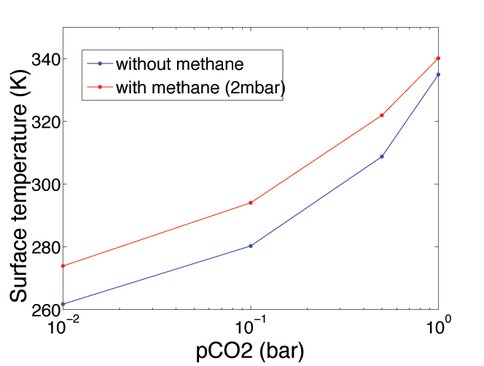2014 Annual Science Report
 VPL at University of Washington
Reporting | SEP 2013 – DEC 2014
VPL at University of Washington
Reporting | SEP 2013 – DEC 2014
Charnay NAI NPP PostDoc Report
Project Summary
My project focuses on the modeling of clouds and photochemical haze in the atmospheres of the early Earth and exoplanets. I use a 3D model, developed to simulate any kind of atmospheres, to study the formation, dynamics, climatic impact and observational features of clouds/haze. My first object of interest is GJ1214b, a mini-Neptune whose observations by HST revealed a cloudy/hazy atmosphere. The formation of such high and thick clouds is not understood. My second object of interest is the Archean Earth for periods with a methane-rich atmosphere leading to the formation of organic haze.
Project Progress
This report covers activities during my first half year of NAI/NPP postdoctoral fellowship (started in August 2014) and the five months that preceded it as a postdoc at the VPL. During this time, I made significant progress on the 3D modeling of clouds in the atmosphere of the exoplanet GJ1214b. I adapted the Generic LMD GCM to include a generic cloud scheme and an internal heat flux for a gaseous mini-Neptune-like planet. I computed opacities for different atmospheric composition at thermochemical equilibrium and optical properties for KCl and ZnS clouds. With this new version of the model, I ran the first 3D simulations of clouds on a gaseous exoplanet. I showed that, for some conditions, sub-micron cloud particles could be lofted to the upper atmosphere of GJ1214b. I produced transit spectra from the outputs of my GCM with SMART, the spectral model of the VPL. The results show that spectra with clouds can match the observations by HST which show a featureless spectrum of the atmosphere (see figure 1). I also produced reflection spectra and phase curves in thermal emission. The particular distribution and optical properties of the clouds could lead to observational features allowing us to decipher GJ1214b’s atmospheric composition. I presented these results at the AAS meeting (Charnay et al., 2015) and two related manuscripts are in preparation. I am planning for next year to study the formation of photochemical haze in the atmosphere of GJ1214b and other warm mini-Neptunes.
In parallel to this work on GJ1214b, I continued my previous study (Charnay et al., 2013) of the early Earth with the Generic LMD GCM. I analyzed hot climates of the late Hadean/early Archean with high amounts of CO2 (up to 1 bar, see figure 2). A paper describing the climate, the carbon cycle and consequences of a hot early Earth is in preparation. For next year, I am planning to study the climates of the Archean Earth with a low atmospheric pressure (0.2-0.5 bar) and the formation and climatic impact of organic haze.
Publications
-
Charnay, B., Forget, F., Wordsworth, R., Leconte, J., Millour, E., Codron, F., & Spiga, A. (2013). Exploring the faint young Sun problem and the possible climates of the Archean Earth with a 3-D GCM. J. Geophys. Res. Atmos., 118(18), 10,414–10,431. doi:10.1002/jgrd.50808
-
PROJECT INVESTIGATORS:
-
PROJECT MEMBERS:
Benjamin Charnay
Project Investigator
David Catling
Co-Investigator
Victoria Meadows
Co-Investigator
-
RELATED OBJECTIVES:
Objective 1.2
Indirect and direct astronomical observations of extrasolar habitable planets.
Objective 4.1
Earth's early biosphere.

